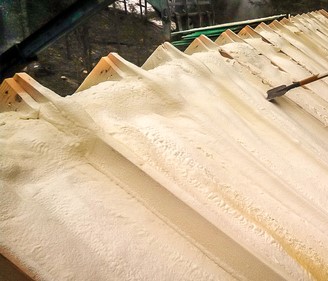
Log homes are known for their unique charm and warm, inviting and cozy atmosphere. However, they can also be more challenging to insulate than traditional homes. Proper insulation is essential to keep your log home comfortable and energy-efficient, as well as prevent issues like moisture buildup and mold growth. In this blog post, we’ll explore the importance of properly insulating your log home and offer tips on how to do it effectively.
The Benefits of Proper Insulation
One of the main benefits of proper insulation is improved energy efficiency. Log homes are naturally energy-efficient due to their thick walls and dense wood, but they can still benefit from additional insulation in the walls and roof. Insulation helps to prevent heat loss in the winter and heat gain in the summer, which can significantly reduce your energy bills and increase the level of comfort in your home.
Another benefit of proper insulation is improved indoor air quality. Insulation helps to prevent moisture buildup and condensation, which can lead to mold growth and other indoor air quality issues. By properly insulating your log home, you can create a healthier and more comfortable living environment for you and your family.
There are several types of insulation that are suitable for log homes, including:
- Fiberglass: Fiberglass insulation is a popular option for log homes. It is relatively affordable, easy to install, and has a high R-value, which measures its insulating ability.
- Cellulose: Cellulose insulation is made from recycled paper and is a more eco-friendly option than fiberglass. It is also more resistant to mold and pests than fiberglass.
- Spray Foam: Spray foam insulation is an excellent option for sealing air leaks and gaps in the walls and roof. It provides a tight seal and can improve energy efficiency by up to 50%.
Here are some tips to keep in mind when insulating your log home:
- Choose the right type of insulation for your needs and budget.
- Consider hiring a professional insulation contractor who has experience working with log homes.
- Be sure to properly seal any air leaks or gaps in the walls and roof before adding insulation.
- Install insulation in the walls, roof, and foundation of your log home for optimal energy efficiency.
- Use a vapor barrier to prevent moisture buildup and mold growth.
- Consider adding insulation to the interior walls of your log home to improve soundproofing and energy efficiency.
Proper insulation is essential to keep your log home comfortable, energy-efficient, and in the best shape. Be sure to choose the right type of insulation for your needs and budget, properly seal any air leaks or gaps, and consider hiring a professional insulation contractor for best results. By taking these steps, you can enjoy your home and keep it as energy efficient as possible year round.








